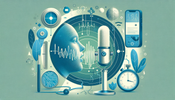Differences Between Type 1 and Type 2 Diabetes

In a perfect world, your pancreas produces the hormone insulin to help move sugar (glucose) from your bloodstream, into your cells. Your cells then turn the sugar into energy to fuel your body. Unfortunately, when your body doesn’t use insulin to create energy for your body - that’s a big problem where your blood sugar remains unregulated. And the problem has a name: diabetes. Diabetes causes high blood sugar levels and can eventually lead to serious, even life-threatening conditions. In general, there are two types of diabetes - Type 1 and Type 2. Let’s go through the main differences between the two types, including the different causes, symptoms, and prevention/management techniques.
What is diabetes?
Type 1 diabetes is when your body doesn’t produce any insulin at all. Instead, your immune system goes on the warpath, attacking and destroying the insulin-producing ‘beta cells’ in your pancreas. If insulin is the key that unlocks the door and gets sugar out of your bloodstream and into your cells, you can think of Type 1 diabetes as not having any keys to open those doors. Instead, sugar just piles up on the wrong side of the door and starts making problems. Type 2 diabetes is when your body produces insulin but isn’t using it the right way - or simply isn’t producing enough of it. The keys to the door (insulin) are there, but they are broken. They aren’t opening doors to your cells to use sugar the way they should. And because your body isn’t regulating your blood sugar well enough, your blood sugar levels aren’t normal.What causes diabetes?
Type 1 diabetes is an autoimmune disease. The exact cause is unknown, but it’s likely genetic - and may also be caused by exposure to certain viruses, like rotavirus, mumps, and Coxsackie. Type 1 can appear at any age, but symptoms usually begin in childhood or young adulthood. That’s why Type 1 has been referred to as juvenile diabetes. Type 2 diabetes may also have genetic or environmental causes, but other risk factors include:- Obesity - extra weight and fat stored around your stomach and waist
- Inactivity - the less active you are, the greater your chance of developing the disease
- Prediabetes - a condition where patients experience slightly elevated blood sugar levels - a possible warning of what’s to come
- Gestational diabetes - those who have previously suffered from diabetes during pregnancy, demonstrating that they are already susceptible to the disease
- Race - Type 2 diabetes is more common among African, Mexican, Asian, and Native Americans, compared to Caucasians
Age also plays a factor in Type 2 diabetes. While incidents among children are growing more prevalent, Type 2 has also been referred to as adult-onset diabetes, and the American Diabetes Association recommends screening for Type 2 diabetes annually for those aged 45 years and above. Basically, if you’re older, you have to be more careful.
What are the symptoms of diabetes?
Type 1 and Type 2 diabetes display similar symptoms. Early symptoms include increased urination, increased thirst and hunger, unexplained weight loss, blurry vision, numbness, tingling, fatigue, and nausea. If you experience any of these symptoms, you should go to a doctor to get checked right away! Possible long-term complications of diabetes are mostly related to the damage of blood vessels, which can impact vision and cause blindness, create pain in the lower extremities and eventually necessitate amputations, lead to kidney failure, and cause cardiovascular disease, heart attacks, or strokes.



